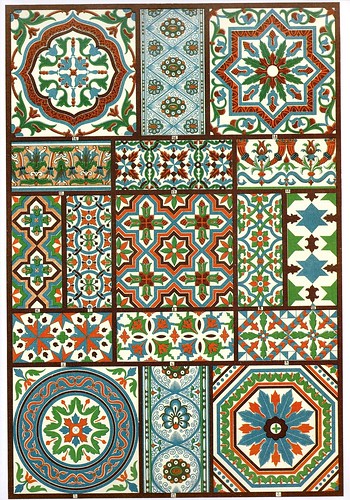
Italian Renaissance Polychrome Pottery
Wainscot and floor plates from houses/buildings in Genoa and Bologna. The ornaments most resemble Byzantine and Oriental models and the studio of Della Robbia [see one; two] attained special celebrity as the leading plate-mosaic manufacturer.
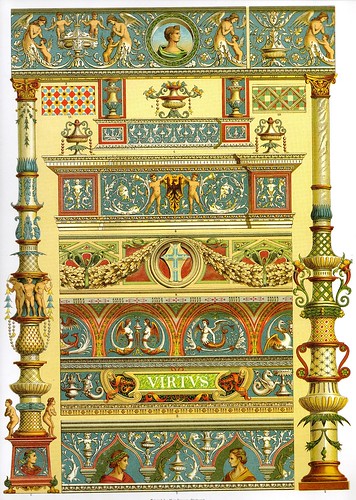
Italian Renaissance Ornamental Painting
House front and court decoration from Genoa, Milan and Pienza.
"It was at the commencement of the 15th century, that the Renaissance style began to make its appearance in Italy, and the period till about 1500 may be called the period of Early Renaissance, in contradistinction of High Renaissance which lasted till the middle of the 16th century.
Renaissance is a new adaptation, not a servile imitation, but a free treatment of antique forms; the plainest evidence of this is given by the ornament, of which this style makes a richer and ampler use than any other. This applies more particularly to the motives we meet with; and here we observe above all the vegetable ornament, which in Early Renaissance generally covers the ground only moderately.
We find almost everywhere delicate, beautifully curved branches in a symmetrical or at least regular arrangement, in which the antique acanthus-leaf acts as the principal part, although, not without the most various transformations. Also vine, laurel, ivy etc. are frequently employed, partly copying nature directly, partly idealised. But this foliage with its branches and fruit is still enlivened by a rich variation of animals, fantastical beings, human figures as well as symbolical subjects, arms, masks, emblems, vases, candelabras etc.
Most cultivated is the combination of human figures and animals with vegetable elements. Finally a not less important part of the decoration are coats or arms and escutcheons, the latter usually a so-called horse-front-shields [the two parallel strips upper middle in the image above] in the period of the Early Renaissance, later on as cartouches."
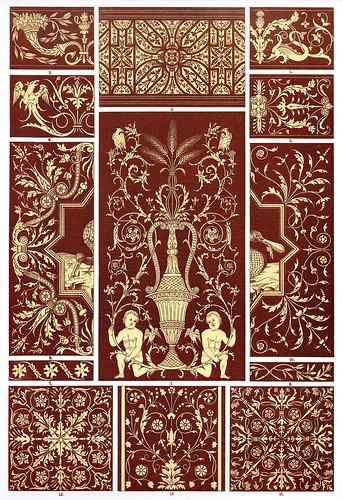
Italian Renaissance Wood Mosaic
Examples from choir stalls in Verona, Organo, Bologna and Pavia. In general, wood carving was highly flourished, particularly the style of woodwork known as intarsia*, where inlaid wood panels were used for stalls, shrines and vestries in churches.
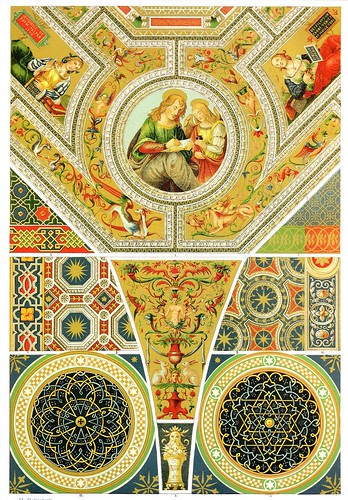
Italian Renaissance Ceiling Painting
Borders, medallions and arch-panels from ceilings in the Vatican, Certosa, Lodi and Rome. Mixed animal and vegetable motive ornamentation, often framed with original fresco border patterns that are themselves often inspired by stucco decoration, except imitated with a brush. Rosette patterns that pre-date the Renaissance become an assimilated form of the developing artistic expression.
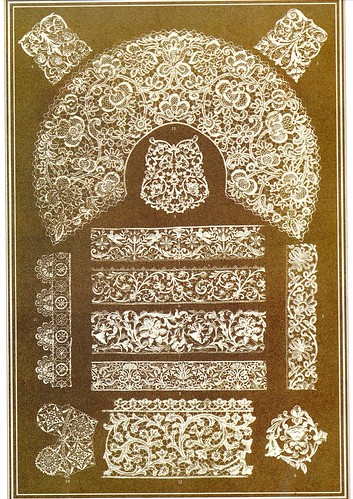
Italian Renaissance Laces
Lace patterns from Venice and Genoa, the two main centres where the perfection of this art-form virtually makes it a creation of the Renaissance. Of the astonishingly intricate and beautiful lace products, Venetian point-in-relief is the most esteemed. The decoration is dominated by vegetable motives, comparable to ornamentation seen in other Renaissance arts.
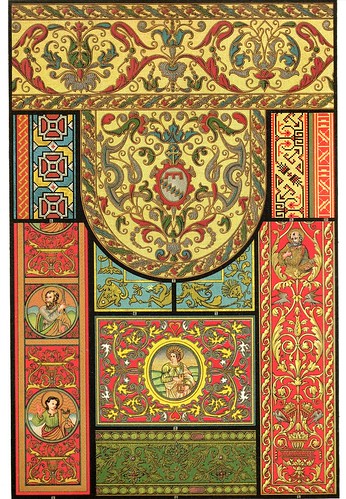
Italian Renaissance Embroidery and Carpet Weaving
Silk, relief and plain embroidered {(+/-) appliqué} examples from liturgical vestments and carpet border patterns from Florence, Verona, Stuttgart and Munich. Embroidery frequently includes medallion designs in addition to the normal Renaissance ornamental repertoire ; carpet weaving often follows Byzantine and Oriental patterns.
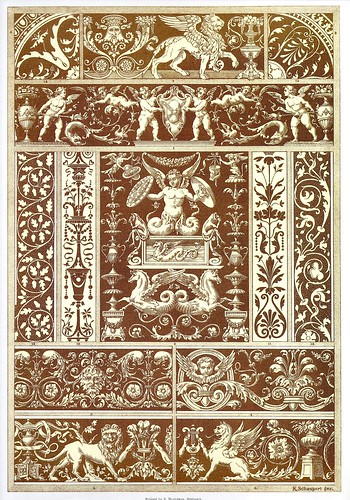
Sgraffiti (earthenware and wall art where designs are scratched into a rendered overlay such as stucco) from houses in Rome, inlaid marble-work from Siena Cathedral and tomb-plates in Venice, Florence as well as basso-relievos from Roman and Venetian tombs.

Italian Renaissance Ceiling and Wall Painting
Ceiling painting in the Palazzo Doria in Genoa, pilaster decoration from Raphael's loggia series at the Vatican and window-niche panels from the Vatican Museum.
The late 15th century discovery of the ancient Domus Aureus [highly recommended: one, two] and particularly the Titus baths, provided Raphael with inspiring ornaments to reinterpret, leading to the creation of new variations of motifs for figures and garlands etc.

Italian Renaissance Illumination, Weaving and Marble-Mosaic
Velvet and silk material decorations, marble table mosaic and various manuscript highlights. Despite the availability of the printing press, there was still a demand during the Renaissance for illumination in prestigious works that required multi-coloured outcomes and highly decorative initials, presenting a varied mixture of ancient, mythological and Christian motifs. The vegetation in the manuscript ornament veered away from the natural towards the stylised. Marble mosaics (eg. the vase above), on the other hand, reproduced natural world elements with some precision.
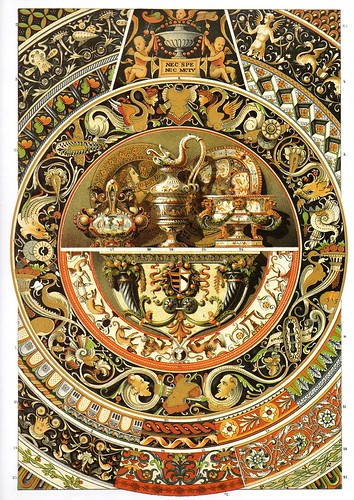
Italian Renaissance Pottery Painting
Profile and border decorations from vases, dishes, fountains and inkstand from Urbino, Florence and Pesaro. Tin-glazing was invented at the end of the 15th century and resulted in a total change in the faience* technique. [I don't understand much of what the author states about majolica-ware]
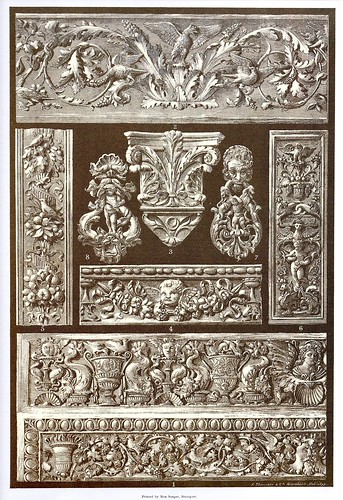
Italian Renaissance Plastic Ornaments in Marble and Bronze
Door lintels and frames, friezes, pilaster strip, and door knockers from palaces and churches in Urbino, Siena and Florence.

Italian Renaissance Ceiling and Wall Painting
Loggia details from the Vatican, borders and pilaster panels from the Villa di Papa Giulio in Rome.
"It is in about the year 1540 that the period of the so-called Late Renaissance begins. [..] We find no more the same charm and grace as in the creations of the Early and High Renaissance, but some cool, rather caluculating feature pervades the whole treatment.
The beautiful harmonious union of the figural with vegetable element, as well as the nicely balanced proportion of the colours to each other are somewhat decaying. The larger admission of white surfaces makes a dry and barren impression upon the spectator.
The vegetable ornament is less elaborately finished, its place being often taken by elements, from which later on the so-called cartouches were developed, and most of the figures do not show to advantage by their artificial composition. Neither in the disposition of this ornament over the field to be decorated, is the perfection of the previous epoch of art within this domain attained."

Italian Renaissance Works in
Precious Metals with Paintings in Enamel
Precious Metals with Paintings in Enamel
Pendants, jug handles, cup cover, shield masks, altar crowning (largest item) and vase decoration from Florence (at least). Some of the work was carried out by French artists. Benvenuto Cellini is considered the leading master of precious metal work from about the middle of the 16th century. "Plants, animals, human figures, frequently in the most strange compositions, by far preponderate over the purely geometric ornament."
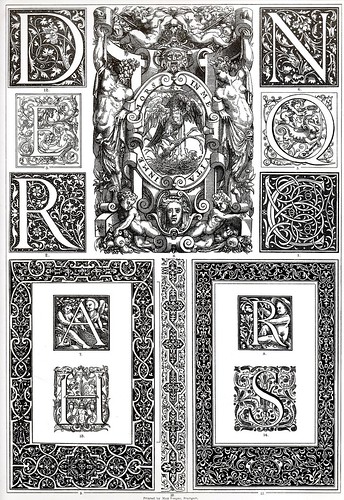
French Renaissance Typographic Ornaments
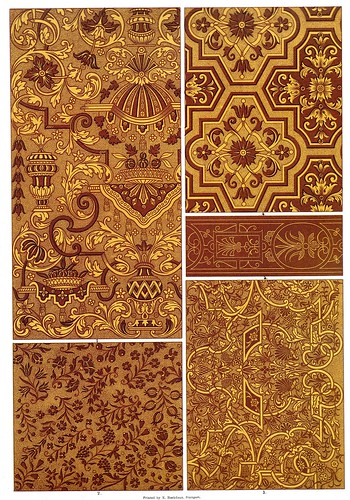
French Renaissance Block Printing and Embroidery

French Renaissance Carpet Painting
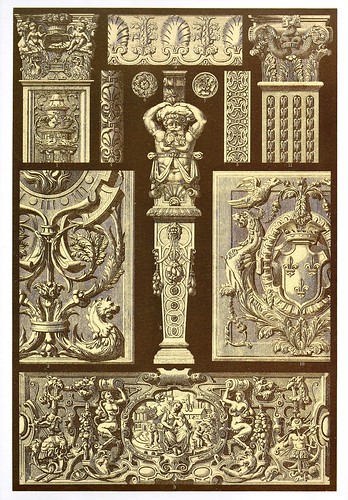
French Renaissance Plastic Ornaments in Stone and Wood
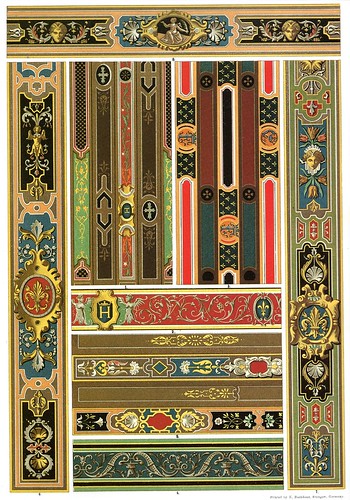
French Renaissance Ceiling Painting
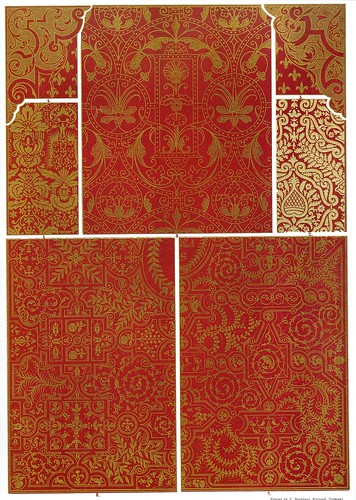
French Renaissance Weaving Embroidery and Book Covers

French Renaissance Wall Painting,
Polychrome Sculpture, Weaving and Book Covers
Polychrome Sculpture, Weaving and Book Covers
More scans from Heinrich Dolmetsch's 'Der Ornamentenschatz' (1887) {The Treasury of Ornament}. [
I suspect the translational anomalies are becoming fairly obvious by now (I have the English publication; it's not me translating). It's reasonable to be at least mildly suspicious about the veracity of all the commentary, although I tend to consider the translation rather than the original as the transmitter of discord, as it were. I tried to verify some elements but, for the most part, I have simply attempted to report or interpret into plain English what I've been reading. And, as I am dumber than a stick at times, there may well be introduced errors in addition to any original inaccuracies. Just so you know.
Previously: Part I and Part II.
Update: I've decided three is enough. But the whole book image series (including 20+ more images that weren't posted on the blog) is accessible from this flickr set.




No comments:
Post a Comment